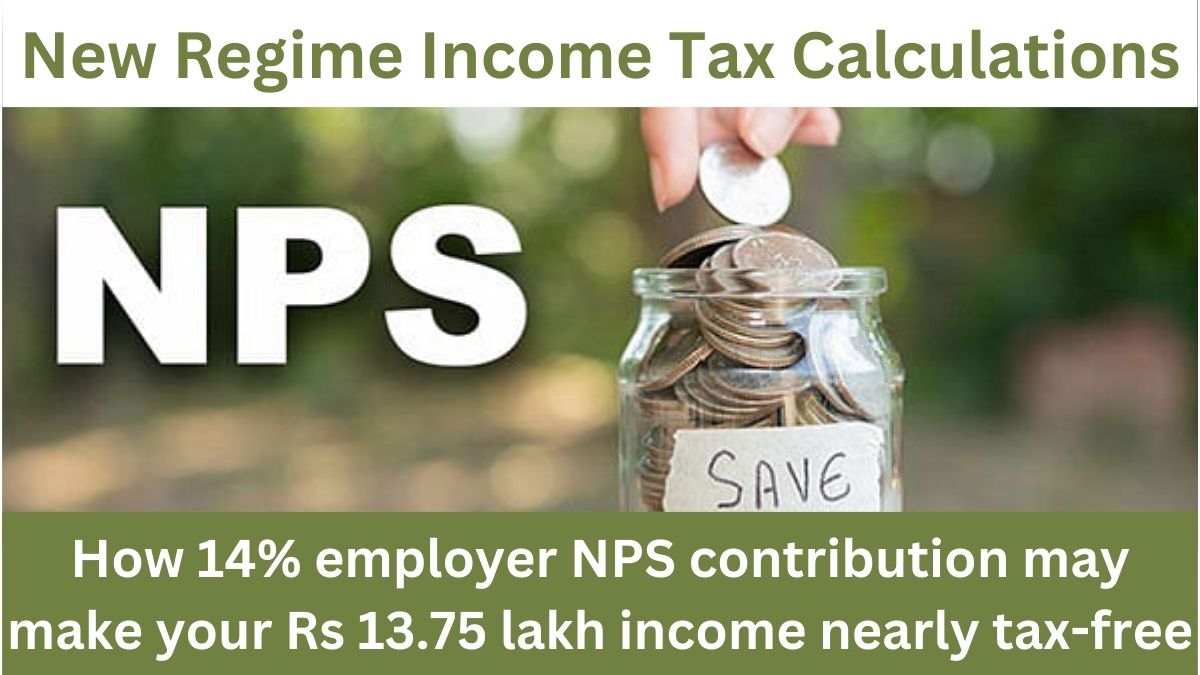With the implementation of the new tax regime from April 1, 2025, salaried individuals can enjoy significant tax benefits. Under the proposed structure, an annual income of up to ₹12,75,000 for salaried individuals will be tax-free. However, a strategic approach leveraging employer contributions to the National Pension System (NPS) can extend this tax-free threshold up to ₹13,75,000.
In this article, we will explore how this mechanism works, the role of employer NPS contributions, and how salaried employees can maximize their tax savings.

Understanding the New Tax Regime and Its Tax-Free Limit
Why is ₹12,75,000 Tax-Free for Salaried Individuals?
The new tax regime introduces a standard deduction of ₹75,000 for salaried taxpayers, reducing their taxable income. This means that an individual earning ₹12,75,000 annually will have a taxable income of:
₹12,75,000 – ₹75,000 (Standard Deduction) = ₹12,00,000
According to the proposed tax slabs, the tax liability for an income of ₹12,00,000 would be ₹60,000. However, the government has also provided a rebate of up to ₹60,000, effectively making the income tax-free.
What is the Role of Employer Contributions to NPS?
The National Pension System (NPS) is a retirement savings scheme where both employees and employers can contribute. Under the new tax regime, employer contributions to an employee’s Tier-I NPS account are eligible for tax benefits.
The government allows a maximum employer contribution of 14% of the basic salary to be tax-exempt. This tax-saving opportunity can help individuals earning ₹13,75,000 reduce their taxable income significantly.
How Employer NPS Contributions Can Make ₹13,75,000 Income Tax-Free
Example Calculation
Let’s assume an individual earns ₹13,75,000 annually. Here’s how they can minimize their tax liability using NPS employer contributions:
-
Basic Salary Assumption:
- Typically, the basic salary constitutes around 50% of the total pay package.
- In this case, the basic salary would be ₹6,87,500 (50% of ₹13,75,000).
-
Employer’s NPS Contribution:
- The maximum allowable employer contribution is 14% of the basic salary.
- 14% of ₹6,87,500 = ₹96,250 (fully tax-exempt).
-
Adjusting Taxable Income:
- Gross income: ₹13,75,000
- Less employer’s NPS contribution: ₹96,250
- New taxable income: ₹12,78,750
-
Applying Standard Deduction:
- ₹12,78,750 – ₹75,000 (Standard Deduction) = ₹12,03,750
-
Final Tax Calculation:
- Since ₹12,00,000 is tax-free under the new tax regime, only ₹3,750 remains taxable.
- Applying income tax rates and 4% education cess, the final tax liability comes out to approximately ₹3,900.
Thus, through this strategic approach, an individual earning ₹13,75,000 can effectively reduce their tax burden to nearly zero.
Summary Table: Tax Optimization Through NPS
| Component | Amount (₹) |
|---|---|
| Total Annual Income | 13,75,000 |
| Employer’s NPS Contribution (14% of Basic) | 96,250 |
| Adjusted Taxable Income After NPS Contribution | 12,78,750 |
| Standard Deduction | 75,000 |
| Final Taxable Income | 12,03,750 |
| Tax-Free Limit | 12,00,000 |
| Taxable Amount | 3,750 |
| Final Tax Payable (Including 4% Cess) | 3,900 |
Key Benefits of Employer NPS Contributions
1. Tax-Free Contribution by Employer
Employers can contribute up to 14% of the basic salary, and this amount is fully tax-exempt under the new regime.
2. Reducing Overall Taxable Income
By leveraging employer contributions, salaried individuals can reduce their effective taxable income, bringing them into a lower tax bracket or even eliminating tax liability altogether.
3. Long-Term Retirement Benefits
NPS contributions are locked in until retirement, ensuring financial security and corpus growth with market-linked returns.
4. Enhanced Savings Without Additional Deductions
Unlike previous tax regimes that required active investments in tax-saving instruments, this method allows passive savings through employer contributions without impacting take-home salary.
Frequently Asked Questions
1. Can I make my entire income tax-free under the new regime?
While income up to ₹12,75,000 is tax-free for salaried individuals, employer NPS contributions can help extend this benefit to ₹13,75,000 with minimal tax liability.
2. Is there a cap on the employer’s NPS contribution for tax benefits?
Yes, the maximum tax-exempt employer contribution to NPS Tier-I is 14% of the basic salary for government employees and 10% for private sector employees.
3. Can I avail of additional deductions under the new tax regime?
The new regime does not allow traditional deductions like 80C (PPF, LIC, EPF) or 80D (Health Insurance). However, standard deduction and employer NPS contributions remain tax-exempt.
4. How does the new tax regime differ from the old one?
The old regime allowed multiple deductions and exemptions, whereas the new regime simplifies tax slabs and eliminates most deductions while offering lower tax rates.
5. Is it mandatory for my employer to contribute to NPS?
No, NPS employer contributions are voluntary and depend on company policies. However, if offered, employees should take advantage of this tax-saving opportunity.
The new tax regime offers a simple and structured way to minimize tax liability. By strategically utilizing employer NPS contributions, salaried individuals earning up to ₹13,75,000 can effectively reduce their tax burden to nearly zero while also securing their retirement savings.
For those looking to optimize their tax planning in 2025, ensuring maximum employer NPS contributions is a smart move that brings both immediate tax relief and long-term financial security.
Click here to know more.
Kishan is a knowledgeable writer specializing in agriculture and the latest government job recruitments, delivering clear and insightful content to inform and empower readers.
